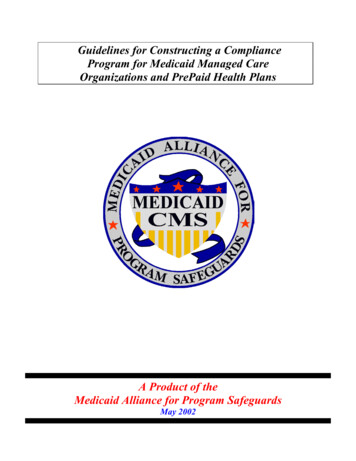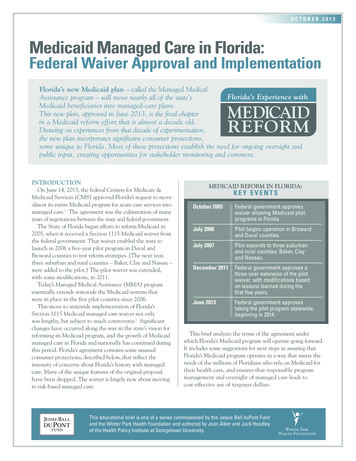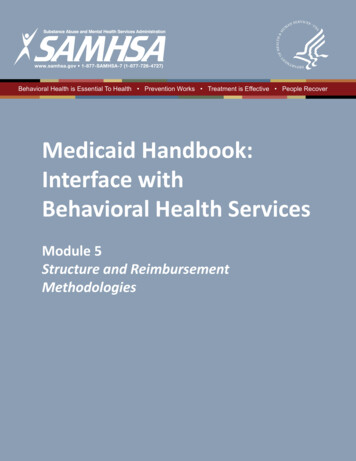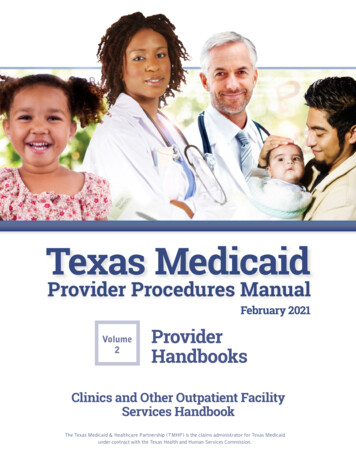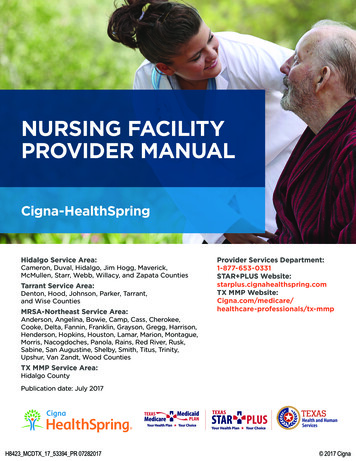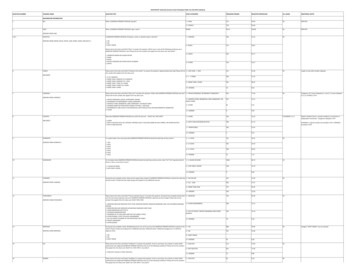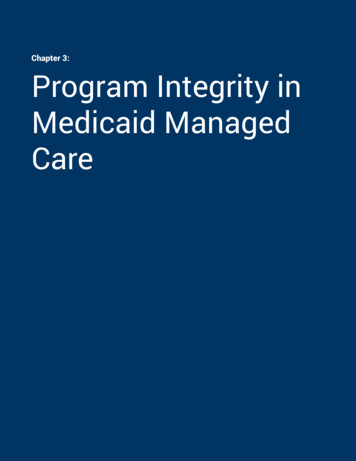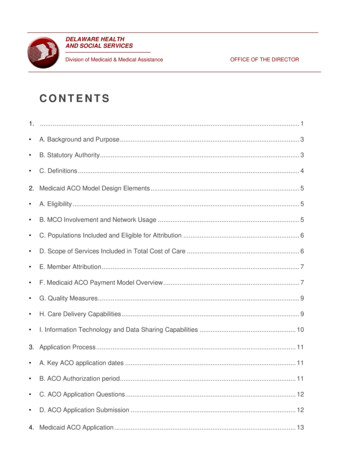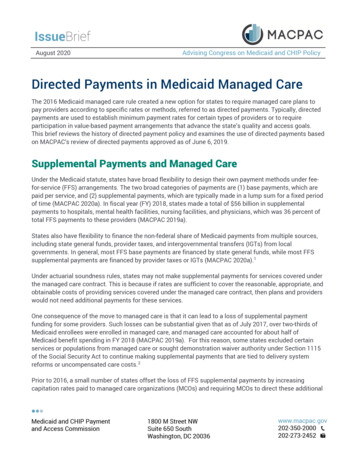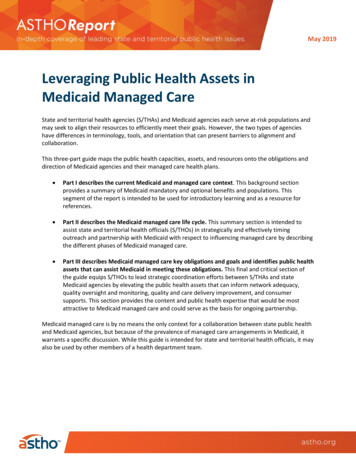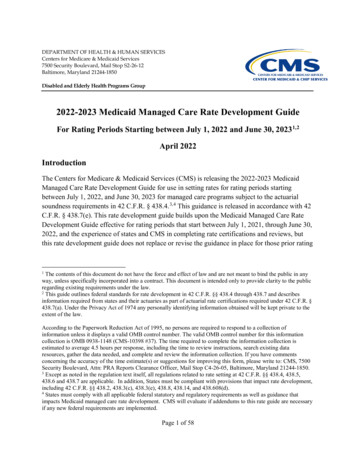
Transcription
DEPARTMENT OF HEALTH & HUMAN SERVICESCenters for Medicare & Medicaid Services7500 Security Boulevard, Mail Stop S2-26-12Baltimore, Maryland 21244-1850Disabled and Elderly Health Programs Group2022-2023 Medicaid Managed Care Rate Development GuideFor Rating Periods Starting between July 1, 2022 and June 30, 2023 1,2April 2022IntroductionThe Centers for Medicare & Medicaid Services (CMS) is releasing the 2022-2023 MedicaidManaged Care Rate Development Guide for use in setting rates for rating periods startingbetween July 1, 2022, and June 30, 2023 for managed care programs subject to the actuarialsoundness requirements in 42 C.F.R. § 438.4. 3,4 This guidance is released in accordance with 42C.F.R. § 438.7(e). This rate development guide builds upon the Medicaid Managed Care RateDevelopment Guide effective for rating periods that start between July 1, 2021, through June 30,2022, and the experience of states and CMS in completing rate certifications and reviews, butthis rate development guide does not replace or revise the guidance in place for those prior ratingThe contents of this document do not have the force and effect of law and are not meant to bind the public in anyway, unless specifically incorporated into a contract. This document is intended only to provide clarity to the publicregarding existing requirements under the law.2This guide outlines federal standards for rate development in 42 C.F.R. §§ 438.4 through 438.7 and describesinformation required from states and their actuaries as part of actuarial rate certifications required under 42 C.F.R. §438.7(a). Under the Privacy Act of 1974 any personally identifying information obtained will be kept private to theextent of the law.1According to the Paperwork Reduction Act of 1995, no persons are required to respond to a collection ofinformation unless it displays a valid OMB control number. The valid OMB control number for this informationcollection is OMB 0938-1148 (CMS-10398 #37). The time required to complete the information collection isestimated to average 4.5 hours per response, including the time to review instructions, search existing dataresources, gather the data needed, and complete and review the information collection. If you have commentsconcerning the accuracy of the time estimate(s) or suggestions for improving this form, please write to: CMS, 7500Security Boulevard, Attn: PRA Reports Clearance Officer, Mail Stop C4-26-05, Baltimore, Maryland 21244-1850.3Except as noted in the regulation text itself, all regulations related to rate setting at 42 C.F.R. §§ 438.4, 438.5,438.6 and 438.7 are applicable. In addition, States must be compliant with provisions that impact rate development,including 42 C.F.R. §§ 438.2, 438.3(c), 438.3(e), 438.8, 438.14, and 438.608(d).4States must comply with all applicable federal statutory and regulatory requirements as well as guidance thatimpacts Medicaid managed care rate development. CMS will evaluate if addendums to this rate guide are necessaryif any new federal requirements are implemented.Page 1 of 58
periods. If states or their actuaries have questions regarding this guidance, please contactMMCratesetting@cms.hhs.gov.This guide outlines federal standards for rate development and describes information requiredfrom states and their actuaries as part of actuarial rate certifications required under 42 C.F.R. §438.7(a). All standards and documentation expectations outlined in this rate development guidefor capitation rates also apply for rate ranges developed in accordance with 42 C.F.R. § 438.4(c)unless otherwise stated. The information outlined in this guide must be included within the ratecertification in adequate detail to allow CMS (or its actuaries) to determine compliance with theapplicable provisions of 42 C.F.R. part 438, including that the data, assumptions, andmethodologies used for rate development are consistent with generally accepted actuarialprinciples and practices and that the capitation rates are appropriate for the populations andservices to be covered. CMS strives to review states’ submissions of rate certification asefficiently as possible, and therefore, this guide describes the required standards for ratedevelopment in accordance with 42 C.F.R. § 438.5 and appropriate documentation for eachsubmission in accordance with 42 C.F.R. § 438.7 to facilitate our review. Adherence by statesand their actuaries to the rate development standards and documentation expectations outlined inthis guide, will aid in ensuring compliance with the regulations and in CMS’s review andapproval of actuarially sound capitation rates and associated federal financial participation. Thefailure to include appropriate documentation may result in additional CMS questions and/orrequests to obtain the information described in the guide as part of our review.Additionally, as part of the CMS effort to review states’ submissions of rate certification asefficiently as possible, CMS implemented an accelerated rate review process. Appendix Acontains additional information regarding this accelerated rate review process and procedures,specifically the criteria that a state must meet for the capitation rates to be eligible for anaccelerated rate review and the rate development summary that states must provide in order to gothrough an accelerated rate review.Section 1903(m)(2) of the Social Security Act (the Act) and 42 C.F.R. § 438.4 require thatcapitation rates be actuarially sound, meaning that the capitation rates are projected to providefor all reasonable, appropriate, and attainable costs that are required under the terms of thecontract and for the operation of the managed care plan for the time period and the populationcovered under the terms of the contract. Such capitation rates are developed in accordance with42 C.F.R. § 438.4(b). In applying the regulation standards, CMS will also use these threeprinciples: the capitation rates are reasonable and comply with all applicable laws (statutes andregulations) for Medicaid managed care; the rate development process complies with all applicable laws (statutes and regulations)for the Medicaid program, including but not limited to eligibility, benefits, financing, anyapplicable waiver or demonstration requirements, and program integrity; andPage 2 of 58
the documentation is sufficient to demonstrate that the rate development process meets therequirements of 42 C.F.R. part 438 and generally accepted actuarial principles andpractices.There are three sections for this guide. The first section applies to all Medicaid managed carecapitation rates. The second section outlines specific concepts that states and their actuaries mustconsider when developing rates that include long-term services and supports (LTSS). The thirdsection focuses on issues specific to new adult group capitation rates. Additionally, Appendix Aoutlines information regarding the accelerated rate review process and procedures.Most of the information discussed in this guide is or should be already part of ongoing actuarialwork and program management in states as part of ensuring compliance with 42 C.F.R. §§ 438.4through 438.7. CMS provides the specific elements to be included in the rate certification toensure compliance with the regulations, consistency in the material that is submitted andtransparency for what is included in federal review. Following CMS guidance included withinthis guide is more likely to result in a faster CMS review and reduce the number of questions. Atthis time, CMS does not prescribe a specific format for supplying this information in the ratecertification although each of the relevant sections below must be discussed in sufficient detail inthe rate certification, including those specified in 42 C.F.R. § 438.7.Throughout this guide, CMS uses the term “rate certification” to mean both the letter (orattestation) from the actuary that specifically certifies that the rates are actuarially sound andmeets the requirements of CMS regulations and any supporting documentation that relates to theletter or attestation, including the actuarial report, other reports, letters, memorandums, othercommunications, and other workbooks or data. In practice, most states provide the informationrequested in the guide in the supporting documentation and not directly in the letter orattestation.In accordance with 42 C.F.R. § 438.7, states must submit to CMS for review and approval allrate certifications for managed care organizations (MCOs), prepaid inpatient health plans(PIHPs), and prepaid ambulatory health plans (PAHPs), concurrent with the review and approvalof the contracts. CMS requests that states submit contract actions, rate certification(s) andassociated supporting documentation as distinct documents within one submission rather thancombining all materials into one electronic document. If multiple rate certifications areassociated with the same contract action(s), CMS requests that states provide the supportingdocumentation that relates to each certification.Section I. Medicaid Managed Care RatesThis section of the guidance is directed to all states setting Medicaid managed care capitationrates (including rate ranges) subject to the actuarial soundness requirements in 42 C.F.R. § 438.4.Page 3 of 58
The rate development and documentation standards outlined below are consistent with 42 C.F.R.part 438 and relevant Actuarial Standards of Practice (ASOPs). Actuaries are required to followall ASOPs as part of the obligation to develop rates and certain payment terms in accordancewith generally accepted actuarial principles and practices. See 42 C.F.R. §§ 438.4 through 438.7.Particularly relevant are ASOP No. 1 (Introductory Actuarial Standard of Practice); ASOP No. 5(Incurred Health and Disability Claims); ASOP No. 12 (Risk Classification (for All PracticeAreas)); ASOP No. 23 (Data Quality); ASOP No. 25 (Credibility Procedures); ASOP No. 41(Actuarial Communications); ASOP No. 45 (The Use of Health Status Based Risk AdjustmentMethodologies); ASOP No. 49 (Medicaid Managed Care Capitation Rate Development andCertification); and ASOP No. 56 (Modeling). ASOP No. 49 is especially relevant because itfocuses on the development of Medicaid managed care rates. The applicable requirements under42 C.F.R. §§ 438.4 and 438.5 are consistent with ASOP No. 49.1. General InformationA. Rate Development Standardsi. Unless otherwise stated, all standards and documentation expectations outlined in thisrate development guide for capitation rates also apply for the development of theupper and lower bounds of rate ranges, in accordance with 42 C.F.R. § 438.4(c).ii. Rate certifications must be done for a 12-month rating period. 5iii. In accordance with 42 C.F.R. §§ 438.4, 438.5, 438.6, and 438.7, an acceptable ratecertification submission, as supported by the assurances from the state, includes thefollowing items and information:(a) A letter from the certifying actuary, who meets the requirements for an actuary in42 C.F.R. § 438.2, who certifies that the final capitation rates or rate ranges meetthe standards in 42 C.F.R. §§ 438.3(c), 438.3(e), 438.4, 438.5, 438.6, and 438.7.(b) The final and certified capitation rates or rate ranges for all rate cells inaccordance with 42 C.F.R. § 438.4(b)(4) or § 438.4(c) for all regions (asapplicable). Additionally, the contract must specify the final capitation rate(s) inaccordance with 42 C.F.R. § 438.3(c)(1)(i).(c) Brief descriptions of the following information (to show that the actuarydeveloping and/or certifying the rates has an appropriate understanding of theprogram for which he or she is developing rates):(i) A summary of the specific state Medicaid managed care programs coveredby the rate certification, including, but not limited to:Per 42 C.F.R. § 438.2, “rating period” means a period of 12 months selected by the state for which the actuariallysound capitation rates are developed and documented in the rate certification.5Page 4 of 58
(A) The types and numbers of managed care plan(s) included in the ratedevelopment (e.g., type means managed care organization(s), prepaidinpatient health plan(s), or prepaid ambulatory health plan(s)).(B) A general description or list of the benefits that are required to beprovided by the managed care plan(s) (e.g., types of medical services,behavioral health or mental health services, long-term care services,etc.), particularly noting any benefits that are carved out of themanaged care program, provided on a non-risk basis by the managedcare plan(s), or that are new to the managed care program in thecovered rating period.(C) The geographic areas of the state covered by the managed care ratesand approximate length of time the managed care program has been inoperation.(ii) The rating period covered by the rate certification.(iii) The Medicaid population(s) covered through the managed care program(s)to which the rate certification applies.(iv) Any eligibility or enrollment criteria that could have a significant influenceon the specific population to be covered within the managed care program(e.g., the definition of medically frail, or if enrollment in managed careplan(s) is voluntary or mandatory).(v) A summary of the special contract provisions related to payment described in42 C.F.R. § 438.6 (e.g., risk-sharing mechanisms, 6 incentive arrangements,States planning to implement one or more risk mitigation strategy(ies) for a future rating period must submitcontract and rate certification documentation to CMS prior to the start of the rating period. This documentation mustinclude contract and rate certification documents that describe the risk mitigation strategy included in the contractbetween the state and the managed care plan. States must supply this information even if the state implemented therisk corridor (or other risk mitigation provision) in a prior rating period. Examples of risk mitigation include (but arenot limited to): reinsurance, stop loss limits, risk corridors, and a minimum MLR with a remittance. For ratingperiods starting on or after January 1, 2021, submission of contract and rate certification documentation of the finalrisk mitigation arrangement(s) prior to the start of the rating period is required to meet the regulatory standard ofdocumenting those arrangement(s) to CMS for the rating period prior to the start of the rating period. CMS willaccept states’ submissions of draft managed care contract actions that are not officially executed and documentationfrom a state’s actuary that may not reflect final full rate development or is limited to a description of the risk sharingarrangement(s). States must submit both contract and rate certification documentation prior to the start of the ratingperiod. The risk mitigation arrangement(s) in the final, executed contract and rate certification documents must beunchanged from the prior submission to CMS for the risk mitigation arrangement(s) to be approvable under 42C.F.R. 438.6(b)(1).6Page 5 of 58
withhold arrangements, state directed payments, 7 pass-through payments,and payments to MCOs and PIHPs for enrollees that are a patient in anInstitution of Mental Disease (IMD)) 8.(vi) If the actuary is certifying rates (not rate ranges) and the state and its actuarydetermine that a retroactive adjustment to the capitation rates is necessary,these retroactive adjustments must be certified by an actuary in a revised ratecertification (CMS would accept a new rate certification or rate amendment) 9and submitted as a contract amendment in accordance with 42 C.F.R. §438.7(c)(2). 10 The revisions to the rate certification must:(A) describe the rationale for the adjustment;(B) describe the data, assumptions and methodologies used to develop themagnitude of the adjustment;(C) describe whether the state adjusted rates in the rating period by a deminimis amount in accordance with 42 C.F.R. § 438.7(c)(3) prior tothe submission of the rate amendment; and(D) address and account for all differences from the most recentlycertified rates.iv. Any differences in the assumptions, methodologies, or factors used to developcapitation rates for covered populations must be based on valid rate developmentstandards that represent actual cost differences in providing covered services to thecovered populations. Any differences in the assumptions, methodologies, or factorsused to develop capitation rates must not vary with the rate of Federal financialparticipation (FFP) associated with the covered populations in a manner that increasesFederal costs. The determination that differences in the assumptions, methodologies,or factors used to develop capitation rates for MCOs, PIHPs, and PAHPs increaseFederal costs and vary with the rate of FFP associated with the covered populationsState direction of managed care plan expenditures under the contract (e.g., value-based purchasing arrangements,multi-payer initiatives, quality/performance incentive programs, and all fee schedules) must meet the requirementsin 42 C.F.R. § 438.6(c) and receive prior approval before implementation.8Additional requirements in 42 C.F.R. § 438.6 apply to the various types of special contract provisions; see SectionI, Item 4, for more discussion.9The rate guide utilizes the term “rate amendment” throughout this guide to reference an amendment to the initialrate certification.10In accordance with 42 C.F.R. § 438.4(c)(2)(ii), States that use rate ranges are not permitted to modify thecapitation rates under 438.7(c)(3).7Page 6 of 58
must be evaluated for the entire managed care program and include all managed carecontracts for all covered populations. 11v. Payments from any rate cell must not cross-subsidize or be cross-subsidized bypayments from any other rate cell.vi. The assumptions used for development of the capitation rates must be consistent withthe effective dates of changes to the Medicaid managed care program (including butnot limited to eligibility, benefits, payment rate requirements, incentive programs, andprogram initiatives).vii. Capitation rates must be developed in such a way that the MCO, PIHP, or PAHPwould reasonably achieve a medical loss ratio, as calculated under 42 C.F.R. § 438.8,of at least 85 percent for the rate year. The capitation rates may be developed in sucha way that the MCO, PIHP, or PAHP would reasonably achieve a medical loss ratiostandard greater than 85 percent, as calculated under 42 C.F.R. § 438.8, as long as thecapitation rates are adequate for reasonable, appropriate, and attainable non-benefitcosts. Under § 438.8(j), the state may choose to impose remittance provisions relatedto this medical loss ratio. The terms and conditions of any remittance must clearly beoutlined in the rate certification and demonstrate compliance with § 438.8(c), whichrequires a State, that elects to mandate a minimum MLR for its MCOs, PIHPs, orPAHPs, to use a minimum MLR equal to or higher than 85 percent.viii. In accordance with 42 C.F.R. § 438.4(c), the State and its actuary may developand certify a range of capitation rates per rate cell as actuarially sound, when all ofthe following conditions are met:(a) The rate certification identifies and justifies the assumptions, data, andmethodologies specific to both the upper and lower bounds of the rate range.(b) Both the upper and lower bounds of the rate range must be certified as actuariallysound consistent with the requirements of 42 C.F.R. § 438.4.(c) The upper bound of the rate range does not exceed the lower bound of the raterange multiplied by 1.05.(d) The rate certification documents the State’s criteria for paying MCOs, PIHPs, andPAHPs at different points within the rate range.11In accordance with 42 C.F.R. § 438.4(b)(1) and 438.7(d), CMS may require a State to provide writtendocumentation and justification that any differences in the assumptions, methodologies, or factors used to developcapitation rates for covered populations or contracts represent actual cost differences based on the characteristics andmix of the covered services or the covered populations.Page 7 of 58
(e) The State does not use as a criterion for paying MCOs, PIHPs, and PAHPs atdifferent points within the rate range any of the following: 12(i) the willingness or agreement of the MCOs, PIHPs, or PAHPs or theirnetwork providers to enter into, or adhere to, intergovernmental transfer(IGT) agreements; or(ii) the amount of funding the MCOs, PIHPs, or PAHPs or their networkproviders provide through IGT agreements.ix. When a State develops and certifies a range of capitation rates per rate cell asactuarially sound consistent with 42 C.F.R. § 438.4(c), the State must:(a) Document the capitation rates, prior to the start of the rating period, for theMCOs, PIHPs, and PAHPs at points within the rate range, consistent with 42C.F.R. § 438.4 (c)(1)(iv).(b) Not modify the capitation rates under 42 C.F.R. § 438.7(c)(3).(c) Not modify the capitation rates within the rate range, unless the State is increasingor decreasing the capitation rate per rate cell within the rate range up to 1 percentduring the rating period. However, any changes of the capitation rate within thepermissible 1 percent range must be consistent with a modification of the contractas required in 42 C.F.R. § 438.3(c) and are subject to the requirements of 42C.F.R. § 438.4(b)(1). Any modification to the capitation rates within the raterange greater than the permissible 1 percent range will require the State to providea revised rate certification for CMS approval, which demonstrates that:(i) the criteria in 42 C.F.R. § 438.4(c)(1)(iv), as described in the initial ratecertification, were not applied accurately;(ii) there was a material error in the data, assumptions, or methodologies used todevelop the initial rate certification and that the modifications are necessaryto correct the error; or(iii) other adjustments are appropriate and reasonable to account forprogrammatic changes.(d) Post on the website, as required in 42 C.F.R. § 438.10(c)(3), the followinginformation prior to executing a managed care contract or contract amendmentthat includes or modifies a rate range:(i) the upper and lower bounds of each rate cell;The state’s criteria for paying managed care plans at different points within the rate range, must comply with theprohibition in 42 C.F.R.§ 438.4(c)(1)(v) and other applicable legal authority.12Page 8 of 58
(ii) a description of all assumptions that vary between the upper and lowerbounds of each rate cell, including for the assumptions that vary, the specificassumptions used for the upper and lower bounds of each rate cell; and(iii) a description of the data and methodologies that vary between the upper andlower bounds of each rate cell, including for the data and methodologies thatvary, the specific data and methodologies used for the upper and lowerbounds of each rate cell.x. As part of CMS’s determination of whether or not the rate certification submissionand supporting documentation adequately demonstrate that the rates were developedusing generally accepted actuarial practices and principles and consistent with theregulatory requirements, CMS will consider whether the submission demonstrates thefollowing:(a) All adjustments to the capitation rates or to any portion of the capitation ratesreferenced in 42 C.F.R. §§ 438.5(b)(4) and 438.5(f) must reflect reasonable,appropriate, and attainable costs in the actuary’s judgment and must be includedin the rate certification.(b) Adjustments to the rates that are performed outside of the rate setting processdescribed in the rate certification are not considered actuarially sound under 42C.F.R. § 438.4. Therefore, the rates will not be considered actuarially sound ifadjustments are made outside of the rate setting process described in the ratecertification.(c) Consistent with 42 C.F.R. §§ 438.7(c) and 438.4(c)(2)(i), the final contractedrates in each cell must match the capitation rates or, for rate ranges that areapprovable under § 438.4(c), be within rate ranges in the rate certification. This isrequired in total and for each and every rate cell.xi. Rates must be certified for all time periods for which they are effective, and acertification must be provided for rates for all time periods. Rates from a previousrating period cannot be used for a future time period without an actuarial certificationof the rates for the new rating period.xii. The state and its actuary should describe the evaluation conducted, and the rationalefor any applicable assumptions included or not included in rate development relatedto the COVID-19 public health emergency within the rate certification. States andtheir actuaries should evaluate state specific, and other applicable national or regionaldata that is available and applicable for determining how to address the direct andindirect impacts of the COVID-19 public health emergency in rate setting. CMSrecommends all states implement a 2-sided risk mitigation strategy for rating periodsimpacted by the public health emergency. Please refer to the CMCS InformationalPage 9 of 58
Bulletin published on May 14, 2020 and COVID Frequently Asked Questions forState Medicaid and CHIP Agencies for further information regarding ratedevelopment and risk mitigation considerations around the COVID-19 public healthemergency. The state must ensure that it complies with the requirements in 42 C.F.R.§ 438.6(b)(1), including that the risk mitigation strategy must be documented in thecontract and rate certification documents for the rating period prior to the start of therating period. 13xiii.Procedures for rate certifications for rate and contract amendments, include:(a) If a state intends to claim FFP for capitation rates, the state must comply with thetime limit for filing claims for FFP specified in section 1132 of the Act andimplementing regulations at 45 C.F.R. part 95. States should timely submit ratecertifications to CMS to help mitigate timely filing concerns.(b) If the actuary is certifying rates (and not rate ranges), the state must submit arevised rate certification when the rates change, except for changes permitted asspecified in 42 C.F.R. § 438.4(c) or 42 C.F.R. § 438.7(c)(3). 14 In accordance with438.4(c)(2)(ii), States that use rate ranges are not permitted to modify thecapitation rates under 438.7(c)(3). 15 CMS standards for a revised rate certificationif the state and its actuary determine that changes are needed within the rate rangeduring the rate year are outlined in Section I, Item 1.A.ix.c of this rate guide.(c) For contract amendments that do not affect the rates and for rate changespermitted as specified in 42 C.F.R. §§ 438.4(c) or 438.7(c)(3), CMS does notrequire a rate amendment from the state. However, if the contract amendmentrevises the covered populations, services furnished under the contract or otherchanges that could reasonably change the rate development and rates, the stateand its actuary must provide supporting documentation indicating the rationale asto why the rates continue to be actuarially sound in accordance with 42 C.F.R. §438.4.(d) New or revised rate certifications are not required for limited payment changes:(i) If the actuary certified rates per rate cell (and not rate ranges), the state mayincrease or decrease the most recently certified actuarially sound capitationPlease see footnote 6 for additional documentation requirements for risk-sharing strategies.For states that implement capitation rate adjustments that result in an increase or decrease of more than 1.5percent from the most recently certified capitation rates for any rate cell, states will need to submit a rate amendmentand contract amendment. The rate amendment must address and account for all differences from the most recentlycertified rates.15States are permitted to either use the rate range option under 42 C.F.R. §§ 438.4(c)(1) or use the de minimis rateadjustment under 438.7(c)(3), but states are not permitted to use both mechanisms in combination.1314Page 10 of 58
rates per rate cell, as required in 42 C.F.R. §§ 438.7(c) and 438.4(b)(4), up to1.5 percent during the rating period, in accordance with 42 C.F.R. §438.7(c)(3). 16(ii) If the actuary certified rate ranges for the rate cell(s), the state may increase ordecrease the capitation rates per rate cell within the certified rate range up to 1percent during the rating period, in accordance with 42 C.F.R. § 438.4(c)(2). 17(iii) If the contract and rate certification specify an approved risk adjustmentmethodology (such as applying risk scores to the capitation rates paid to themanaged care plan(s)), the state may apply that specified methodology toincrease or decrease payment to the managed care plan(s), in accordance with42 C.F.R. § 438.7(b)(5)(iii). The changes to payment in this situation arewithin the scope of the original, approved rate certification and contract thatwas reviewed and approved by CMS. The State must provide to CMS thepayment terms updated by the application of the risk adjustment methodologyconsistent with § 438.3(c).(e) Any time a rate changes for any reason other than application of an approvedpayment term (e.g., risk adjustment methodology), which was included in theinitial managed care contract, the state must submit a contract amendment toCMS, even if the rate change does not need a rate amendment.(f) State Medicaid program features are sometimes invalidated by courts of law, orby changes in federal statutes, regulations or approvals. A state must submit acontract amendment and rate amendment to adjust capitation rates to addresschanges in applicable law or losses of program authority. The rate amendmentmust take into account the effective date of the loss of program authority. EachWhile a rate amendment to the actuarial certification is not required in accordance with 42 C.F.R. § 438.7(c)(3),states must submit a contract amendment to effectuate any rate adjustment as the final ca
rate development guide for capitation rates also apply for the development of the upper and lower bounds of rate ranges, in accordance with 42 C.F.R. § 438.4(c). ii. Rate certifications must be done for a 12-month rating period. 5 iii. In accordance with 42 C.F.R. §§ 438.4, 438.5, 438.6, and 438.7, an acceptable rate
